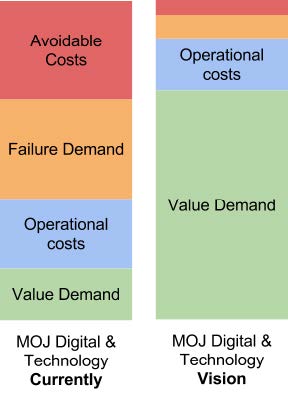The real long-term costs of running IT or software – and why it makes sense to invest in improvements to avoid expensive glitches later on.
Many organisations don’t keep a proper track of all the long-term costs of running a complex IT system. They often cut corners and end up paying much more further down the line, for instance if the system falls over.
This is not just about keeping things ticking over. You also have to invest in regular improvements to keep the system in good shape. This should save you money in the long run and provide a better service for your customers.
Value demand
'Value demand' is demand for work which adds value to the service.
You should keep improving your technology to meet the changing needs of your users. You'll need to:
- listen to customer feedback
- respond to changes to the business or in the marketplace
- fix bugs and security risks
- regularly upgrade your software or hardware
You have to keep on top of all this if you want to avoid the hidden costs of propping up a ramshackle old system.
Operational costs
These are the essential costs of keeping a service up and running, including:
- hosting
- software licences
- helpdesks
- business continuity testing
- user management
Failure demand
'Failure demand' is when you have to pay for extra costs because you've let down your users with a poor service.
This could include:
- extra calls to your helpdesk
- training courses because your system isn't easy to use
- getting a creaky system fixed or replaced when it falls over
When you tally up all these costs you soon realise that scrimping on improvements is a false economy.
Avoidable costs
You may be able to avoid some costs if your organisation is weighed down by governance or if you don't have the right team structure in place.
Meetings are a secret killer of productivity and can be very expensive – especially when there are lots of senior people present.
You should be able to avoid recurring, long meetings to discuss things like deployment, which should be automated as much as possible.
If you have a team dedicated to running your service you could also save time and money in handoffs – for instance, getting a first-line support team up to speed on problems with a product.
Types of cost and examples
| Category of cost | Types of cost | Examples |
|---|---|---|
| Value demand | Responding to feedback or procedural changes | Making continuous improvements based on customer feedback or changes to the law, policy or procedures. |
| Patching | Fixing security vulnerabilities and other bugs. | |
| Upgrades | Modernising components, such as upgrading a network to support growing bandwidth or updating code libraries. | |
| Operational costs | Running the service | Hosting, software licences, helpdesks and business continuity testing. |
| Managing users | People to administer the service, as well as managing users, roles, passwords, etc. | |
| Failure demand | Responding to incidents | Identifying and fixing incidents like the service going down. |
| Handling security or compliance breaches | Investigating the breaches, legal costs, etc. | |
| Training | Training courses if you're system isn't intuitive or easy for staff or professionals to use. | |
| Workarounds | Extra admin work to get around the limitations of a system – retyping info from one system to another or scanning in documents. | |
| Technical debt and risk | Paying vendors more to support older software. | |
| Avoidable costs | Governance | Lots of meetings with senior staff present or too many reviews and sign-offs. |
| Hand-offs | Passing work between teams because you don't have a team dedicated to the service. |
More value, less failure
We currently spend too much on avoidable costs or failure demand, and not enough on adding value.
In the future we want to make continuous improvements to our services, to cut out avoidable costs.
This will involve making sustainable business cases, as well as tracking the cost of when things go wrong.

We're also making sure that every technology system has a product owner, responsible for the roadmap for the service and prioritising investment.
Are you involved in running an IT system or a software application? We'd love to know what you think about how we can save costs and create more sustainable services.
Don't miss out on future blog posts: sign up for email alerts.

2 comments
Comment by Jerry Smith posted on
Difficult to argue with the logic and common sense here. Additionally there are often significant hidden Failure Demand costs, productivity hits and increased security vulnerabilities from development of 'Shadow IT' through lack of sustained investment in services.
Comment by Mike posted on
Meanwhile in our office we are still using Windows XP with no upgrade in sight.